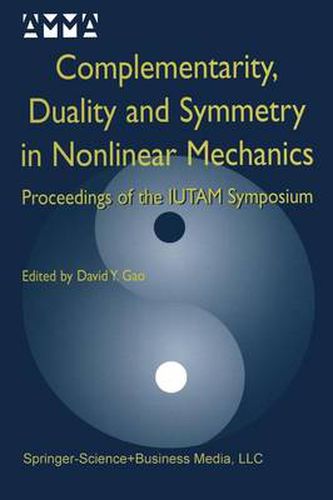Readings Newsletter
Become a Readings Member to make your shopping experience even easier.
Sign in or sign up for free!
You’re not far away from qualifying for FREE standard shipping within Australia
You’ve qualified for FREE standard shipping within Australia
The cart is loading…






This title is printed to order. This book may have been self-published. If so, we cannot guarantee the quality of the content. In the main most books will have gone through the editing process however some may not. We therefore suggest that you be aware of this before ordering this book. If in doubt check either the author or publisher’s details as we are unable to accept any returns unless they are faulty. Please contact us if you have any questions.
Complementarity, duality, and symmetry are closely related concepts, and have always been a rich source of inspiration in human understanding through the centuries, particularly in mathematics and science.
The Proceedings of IUTAM Symposium on Complementarity, Duality, and Symmetry in Nonlinear Mechanics brings together some of world’s leading researchers in both mathematics and mechanics to provide an interdisciplinary but engineering flavoured exploration of the field’s foundation and state of the art developments. Topics addressed in this book deal with fundamental theory, methods, and applications of complementarity, duality and symmetry in multidisciplinary fields of nonlinear mechanics, including nonconvex and nonsmooth elasticity, dynamics, phase transitions, plastic limit and shakedown analysis of hardening materials and structures, bifurcation analysis, entropy optimization, free boundary value problems, minimax theory, fluid mechanics, periodic soliton resonance, constrained mechanical systems, finite element methods and computational mechanics. A special invited paper presented important research opportunities and challenges of the theoretical and applied mechanics as well as engineering materials in the exciting information age.
Audience: This book is addressed to all scientists, physicists, engineers and mathematicians, as well as advanced students (doctoral and post-doctoral level) at universities and in industry.
$9.00 standard shipping within Australia
FREE standard shipping within Australia for orders over $100.00
Express & International shipping calculated at checkout
This title is printed to order. This book may have been self-published. If so, we cannot guarantee the quality of the content. In the main most books will have gone through the editing process however some may not. We therefore suggest that you be aware of this before ordering this book. If in doubt check either the author or publisher’s details as we are unable to accept any returns unless they are faulty. Please contact us if you have any questions.
Complementarity, duality, and symmetry are closely related concepts, and have always been a rich source of inspiration in human understanding through the centuries, particularly in mathematics and science.
The Proceedings of IUTAM Symposium on Complementarity, Duality, and Symmetry in Nonlinear Mechanics brings together some of world’s leading researchers in both mathematics and mechanics to provide an interdisciplinary but engineering flavoured exploration of the field’s foundation and state of the art developments. Topics addressed in this book deal with fundamental theory, methods, and applications of complementarity, duality and symmetry in multidisciplinary fields of nonlinear mechanics, including nonconvex and nonsmooth elasticity, dynamics, phase transitions, plastic limit and shakedown analysis of hardening materials and structures, bifurcation analysis, entropy optimization, free boundary value problems, minimax theory, fluid mechanics, periodic soliton resonance, constrained mechanical systems, finite element methods and computational mechanics. A special invited paper presented important research opportunities and challenges of the theoretical and applied mechanics as well as engineering materials in the exciting information age.
Audience: This book is addressed to all scientists, physicists, engineers and mathematicians, as well as advanced students (doctoral and post-doctoral level) at universities and in industry.